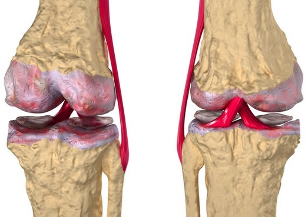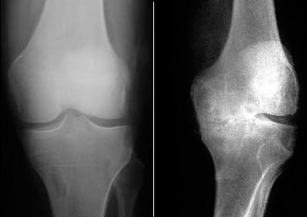All synovial joints are degenerate-degenerative diseases – arthritis, but some more, some less. Typically infects the osteoarthritis of the knees and the hip joint, because they get overloaded, and the knee joints and injuries. If the osteoarthritis is localized in the knees, the diagnosis is confirmed knee osteoarthritis (deforming arthrosis of the knee). Osteoarthritis of the knee is a disease, which frequently results in both temporary loss of working capacity, and disability. What is osteoarthritis of the knee joint, for any reason, it develops and how it manifests this disease, how to deal with the topic of this article.

A bit of the terminology
Osteoarthritis – non-inflammatory joint disease, which begins with calcifications of the articular processes, with guidance in the cartilage, and then engage in the process of joint with guidance to the location of the bones that articulate, the shell, the muscles that keep at a right angle. Another name for this disease – osteoarthritis, which contains the indication of the pathological process occurring in the bone.
In order to specify the location name of the disease was added to the name of the authority: osteoarthritis of knee, osteoarthritis of the ankle. Given that in the later stage of territorial expansion of the joint of the sites lead to that expressed by the deformation of the authority, the osteoarthritis of the knee and other problems of joints joints is called deformation, the abbreviation of DOA. The diagnosis of DOA means the same thing as osteoarthritis.
What is osteoarthritis and how is it called? Very often on the internet it is possible to find phrases osteoarthritis of the knee, osteoarthritis of the hip. If the first definition is tautology, the second is a mixture of the names of the two types of joint diseases. The fact that for the convenience of the symbols of the most common types of osteoarthritis use names that refers to the location. So, the first part of the complex of the word "knee osteoarthritis" it goes back to the ancient word that means "knee". That is to say, knee osteoarthritis is the osteoarthritis of the knee, you can also use the name of the DOA of the knee, the knee osteoarthritis. And here are the names of osteoarthritis of the knee, and the like are redundant.
Anatomy of the knee
In the literature one can also find references about osteoarthritis femoro-patellar joint or patellofemoral syndrome. To understand what it is, it is necessary to become familiar with the anatomy of the knee. Is condylar at a right angle:
- joint surface of the thigh bone is a convex crown;
- of the tibia – of the cavity.
In addition to the major bones in the education of the knee is a small sesamoid bone, known as the knee cup or patellar. The back of the top edge of the articulated with the thigh. The knee cup in latin is called the patella, and the thigh – femurs. That is to say, if you translate into Spanish the word femoropatellar, is obtained in the femoral-patella. Is not independent of the joint, and part of the complex of the knee joint. Patellar held in the correct position the system of ligaments, but sometimes moves due to an injury or initially has a configuration that causes the instability.
The displacement, instability of the kneecap – the main factors that lead to the development of the so-called patellofemoral of osteoarthritis. Its causes are also referred to traumatic damage to the cartilage of the patella, shock, falls. The specialists typically use the term patellofemoral pain syndrome, because the mechanism of development and the clinical picture of this pathology is are different from the classic, typical of osteoarthritis. This disease is treatable, because the thinning of the cartilage (chondromalacia) only occurs in 3 stages, the prognosis is quite favorable. But in the absence of a proper treatment of this disease comes in knee osteoarthritis.
The cause of the disease
What is osteoarthritis of the joints of the knee and what are the reasons that cause it? One that we have already called – injury and instability of the patella, launched patellofemoral syndrome (physicians often see it as periartroz).
The causes of osteoarthritis of the knee are:
- innate weakness musculo-ligamentous apparatus, the stabilization of the knee joint;
- vascular pathologies of the lower extremities (varicose veins, thrombophlebitis), because it alters the blood supply of the knee;
- the long inflammatory processes in the joint cavity and periarticular tissues;
- endocrine diseases, especially diabetes mellitus;
- injuries of the lower extremities.
Osteoarthritis of the joints of the knee threat to the people, diagnosed of DOA in the ankle, dysplastic, flat feet. The defeat of ankle or hip joints, the violation of the base of support of the function of the foot increases the pressure on the knees. With age, the incidence of osteoarthritis of the knee increases. This is due to the deceleration of the processes of change and the processes of regeneration, circulatory disorders, natural wear and tear on the cartilage tissue, changes hormone.
Knee osteoarthritis at an early age often develops in individuals with a hereditary predisposition, genetic defects of the connective tissue. They are also affected athletes and people who work heavy work a physical with the load on the legs. Severe damage to the knee joints by the excess weight.
The symptoms of the

When arthritis any location of the symptoms gradually grow from one stage to another. In the 1 stage of gonartrosisy the patient experiences discomfort:
- legs get tired quickly;
- at the beginning of the movement occurs in the short-term pain, feeling of tightness, of oppression, but about a half hour, these symptoms disappear;
- the pain can be resumed after a long load, but happens after the holidays.
In the 2nd stage of quite low load, to cause pain, and requires a longer stay, for she has passed. Since in this phase often ignites the shell, headaches bind inflammatory that occur in the resting state. For the synovitis characteristic is the increase of the knee by the accumulation of inflammatory effusion in the cavity joint, with guidance from the, the skin reddens, becomes hot to the touch.
If in an early stage of contractures (limitation of movement joint guidance), mostly associated with painful sensations in the movements, while, as a disease of the joint of the knee progresses, the contractions become resistant. Grow osteophytes that prevent the movements that shorten and lose their elasticity of the ligaments, weakening the muscles, decreases the production of guided intra-articular lubrication of synovial fluid. In the 3 stage of the movement amplitude is strongly reduced, some patients may only perform rocking motion in the knee. Finally, in the later stage of the joint, deformed by bony growths, leg, knee bent a peruvian (X-shape or in the form of deformation).
What is osteoarthritis of the joints of the knee and what are the symptoms that allow to distinguish it from patellofemoral syndrome? For the latter, it is observed:
- the pain, which is located in the front of the knee, normally feel when Jogging, are intensified when you squat, the ascent of a chair, walking the stairs;
- swelling in the area of the kneecap;
- limping gait;
- the clicks on the movements and clicks and the pain does not occur at the same time.
Swelling of the knee, the change of gait, a syndrome of pain of knee osteoarthritis, but the pain that is felt in the depth of the joint, often suffers from its back. The movement often accompanied by pain and crepitus. To determine with precision the localization of the process, you need functional tests and x-rays.
The methods of diagnosis
The diagnosis of DOA is put on after a complete study of the patient. First, the doctor hears the complaint, examines the history, examines your feet, you feel the joints, performs passive movements and asks the patient to perform a series of assets. Knee osteoarthritis is unilateral and bilateral. Unilateral defeat healthy of the finiteness of comparing it with the patient. Evaluate the amount of motion, muscle strength, measured loops of the hips and thighs, the length of the legs. Because knee osteoarthritis is accompanied by atrophy of the muscles and ligaments, affected foot to reduce the volume and the possibility to shorten.
After a physical survey is prescribed and hardware laboratory:
- the main method of diagnosis of osteoarthritis – x-rays, the imaging is performed in at least 2 projections;
- Ct scan-type of x-ray examination, which is posloynoe the image of the joint;
- to evaluate the state of cartilage, the soft tissue, the amount of guided intra-articular fluid that allows the ultrasound;
- very informative method of diagnosis is magnetic resonance imaging;
- the analysis is assigned, to distinguish the arthrosis, arthritis and other inflammatory diseases.
In the diagnosis and to determine the degree of osteoarthritis of the knee joints are based on the data of the x-rays.
- Small, usually uneven narrowing of the joint cleft, initial osteophytes in the form of a small tapering of the edges articular of sites.
- The narrowing joint guidance of the body in a 50% and larger, multiple osteophytes, board of bone (osteosclerosis) in the places of greatest activity. In the background of the foci of the osteosclerosisy can experience the illumination – testopodobnymi of the cavity.
- The almost total absence of joint-guided lumen, expressed osteosclerosis, severe osteophytes, deformation of the articular surfaces of the bones, smoothing the terrain, the curvature of the axis of the limb.
The treatment of the
The next question: what is osteoarthritis of the joints of the knee and how to fight it? Methods for the treatment of this disease are various, it is important that the holistic approach, the combination of medical therapies and non-drug therapy. Treatment should be initiated with the limit of the load on the knees. To do this, you must give up the run, jumps, weight lifting, overweight patients should lose weight.
Those whose muscles are weakened due to sedentary life, you should move more, but not to overload the knee joints. The footwear should be comfortable, when walking it is recommended the use of a cane, also an orthopedist can pick up knee pads, orthosis and other devices for unloading and stabilization of the joint. Must necessarily to follow the diet.
The pharmacological treatment

How to cure osteoarthritis, if accompanied by pain? More often its trimmed with the help of nonsteroidal anti-inflammatory drugs, taken orally and used in the form of ointments, gels. Additionally it is prescribed irritating ointment. With the intense inflammatory process can be displayed by the injection into the joint of the hormonal drugs in combination with local anesthetics. But this treatment only relieves the symptoms, they are short of change, according to the indications.
1 to 2 phases of symptomatic treatment necessarily is combined with the long duration of the receipt of the chondroprotectors. These medications decrease the destruction of cartilage tissue, and at an early stage, even contribute to your recovery. Well relieve pain and regain mobility guided intra-articular injections of hyaluronic acid.
Medications to osteoarthritis can also be assigned vasodilators and drugs to improve the microcirculation, their reception of the shows in case of violation of the vascularization of the joint. Relieve muscle spasms help muscle relaxants. Tool specific for the treatment of osteoarthritis, along with protective cartilage is a medication that neutralizes the activity of a protein that destroys the cartilage, shaving the fabric.
Non-drug treatment
Is displayed when gonartrosise the joints of the knee and non-drug treatment. The methods of non-drug therapy are:
- physical therapy procedures of electrophoresis, ultrasound, magnetotherapy, laser therapy, uht, ufo, and others;
- applique wax, ozokerite;
- compresses with dimexide, doctor, of the bile, bischofite;
- massage with effects primarily not to the joint and muscles;
- chiropractic – applying traction or gentle reduction of the joint;
- Physiotherapy, gym medicinal. Master the training exercise video, the descriptions of the complex of the photo, but it is best to start training under the supervision of an instructor.
In a series of clinics pass the test of an innovative method for the treatment of stem cell therapy. You can restore the cartilage, shaving the fabric, without resorting to a type of surgical intervention.
In the 1 stage of knee osteoarthritis is shown exclusively conservative treatment, starting from 2 can be carried out the surgical intervention. The most progressive of the operation to osteoarthritis:
- arthroscopic debridment – removal of the osteophytes, the live loads and dead of the plots of the cartilage through a small incision;
- arthroscopic chondroplasty – "repair" in the cartilage, a joint with guided;
- arthroplasty hip replacement.
The first two operations are performed normally in 2 stages, give the temporary effect of 1 to 2 years. The total knee replacement is shown in the 3-stage osteoarthritis of the knee, is the only way to avoid disability. Implants serve 15 to 20 years, after which, it is necessary to return to the operation.
Knee osteoarthritis, or osteoarthritis of the joints of the knee between the three most common species of the arthritis. Pain in the knee may indicate not only in the development of osteoarthritis, but also an injury to the ligaments or meniscus, arthritis and a host of other diseases. Therefore, when the anxiety of the symptoms is necessary to consult a doctor and have tests.
Often, osteoarthritis of the knee is progressing slowly, since the appearance of the first symptoms up to total loss of function of the joint you can spend a couple of decades. Completely curing knee osteoarthritis you can not, but if you start the treatment at an early stage, the greater the chance of slowing its development and delaying the last stage, which results in disability.



































